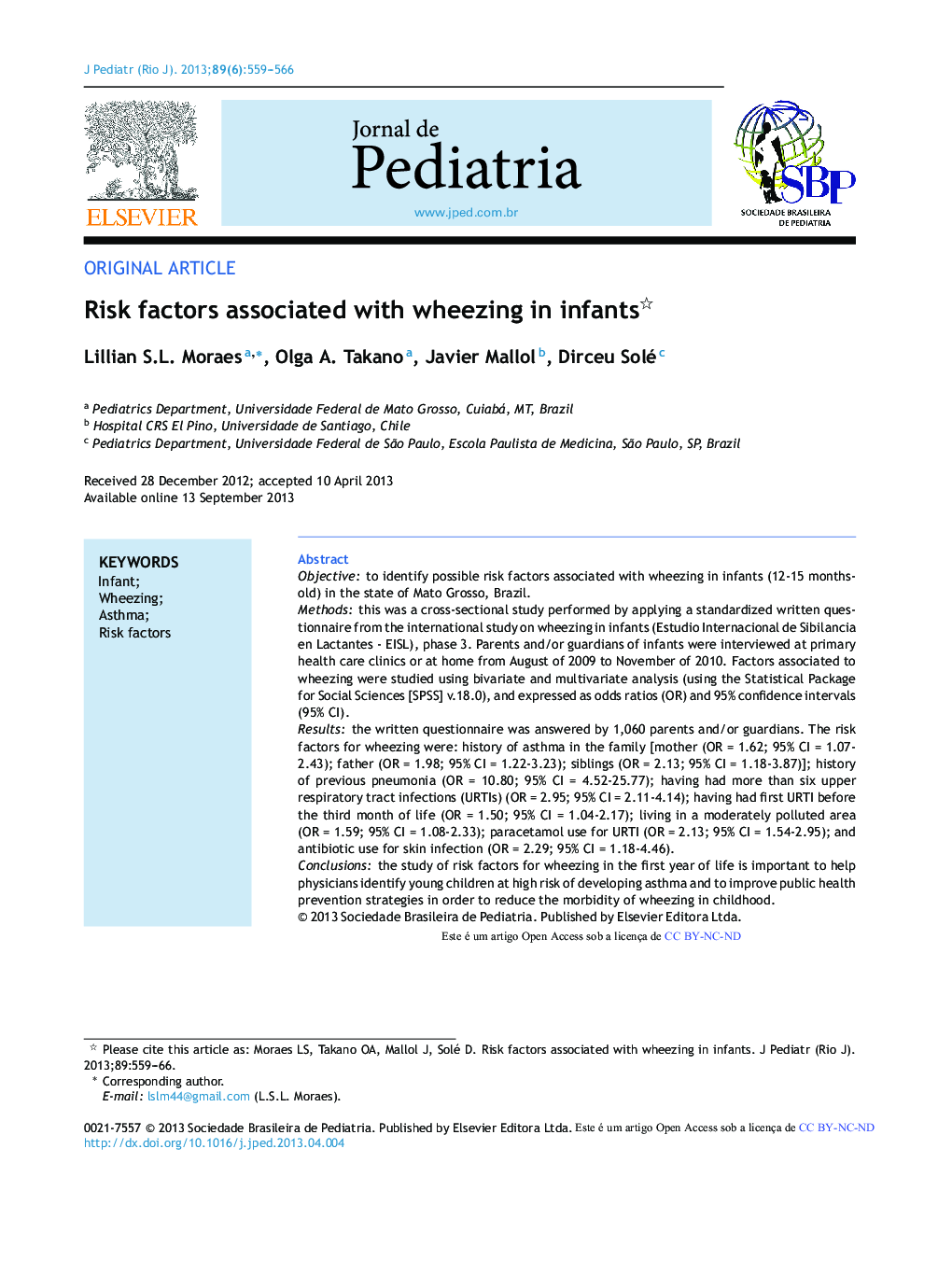| کد مقاله | کد نشریه | سال انتشار | مقاله انگلیسی | نسخه تمام متن |
|---|---|---|---|---|
| 4154137 | 1273694 | 2013 | 8 صفحه PDF | دانلود رایگان |

Objectiveto identify possible risk factors associated with wheezing in infants (12-15 months-old) in the state of Mato Grosso, Brazil.Methodsthis was a cross-sectional study performed by applying a standardized written questionnaire from the international study on wheezing in infants (Estudio Internacional de Sibilancia en Lactantes - EISL), phase 3. Parents and/or guardians of infants were interviewed at primary health care clinics or at home from August of 2009 to November of 2010. Factors associated to wheezing were studied using bivariate and multivariate analysis (using the Statistical Package for Social Sciences [SPSS] v.18.0), and expressed as odds ratios (OR) and 95% confidence intervals (95% CI).Resultsthe written questionnaire was answered by 1,060 parents and/or guardians. The risk factors for wheezing were: history of asthma in the family [mother (OR = 1.62; 95% CI = 1.07-2.43); father (OR = 1.98; 95% CI = 1.22-3.23); siblings (OR = 2.13; 95% CI = 1.18-3.87)]; history of previous pneumonia (OR = 10.80; 95% CI = 4.52-25.77); having had more than six upper respiratory tract infections (URTIs) (OR = 2.95; 95% CI = 2.11-4.14); having had first URTI before the third month of life (OR = 1.50; 95% CI = 1.04-2.17); living in a moderately polluted area (OR = 1.59; 95% CI = 1.08-2.33); paracetamol use for URTI (OR = 2.13; 95% CI = 1.54-2.95); and antibiotic use for skin infection (OR = 2.29; 95% CI = 1.18-4.46).Conclusionsthe study of risk factors for wheezing in the first year of life is important to help physicians identify young children at high risk of developing asthma and to improve public health prevention strategies in order to reduce the morbidity of wheezing in childhood.
ResumoObjetivoidentificar possíveis fatores de risco associados à sibilância em lactentes (12 a 15 meses) no estado de Mato Grosso, Brasil.Métodosestudo transversal, utilizando o questionário escrito padronizado do Estudio Internacional de Sibilancia en Lactantes (EISL) – fase 3. Pais e/ou responsáveis pela criança foram entrevistados em Unidades Básicas de Saúde quando as procuravam para imunização de rotina ou durante visitas nos domicílios de crianças matriculadas nos programas de saúde da família, no período de agosto de 2009 a novembro de 2010. Fatores associados à sibilância foram avaliados utilizando análise bivariada e multivariada e expressos como odds ratio (OR) e intervalo de confiança 95% (IC95%).Resultadosao todo, um mil e sessenta (n = 1.060) pais e/ou responsáveis responderam o questionário escrito. Os fatores de risco para sibilância foram: história familiar de asma [mãe (OR = 1,62; IC95%= 1,07-2,43); pai (OR = 1,98; IC95% = 1,22-3,23); irmãos (OR = 2,13; IC95% = 1,18-3,87)]; história prévia de pneumonia (OR = 10,8; IC 95% = 4,52-25,77); ter mais de seis infecções de vias aéreas superiores (IVAS) (OR = 2,95; IC95% = 2,11-4,14) e a primeira IVAS antes dos três meses de idade (OR = 1,50; IC95% = 1,04-2,17); residir em local com moderada poluição (OR = 1,59; IC95% = 1,08-2,33); uso de paracetamol por IVAS (OR = 2,13; IC95% = 1,54-2,95); e uso de antibiótico por infecção na pele (OR = 2,29; IC 95% = 1,18-4,46).ConclusõesO estudo dos fatores de risco para sibilância no primeiro ano de vida é importante para auxiliar na identificação, entre os lactentes sibilantes, aqueles de alto risco para desenvolver asma, e para o desenvolvimento de estratégias de prevenção por políticas pública de saúde visando minimizar a morbidade da sibilância na infância.
Journal: Jornal de Pediatria - Volume 89, Issue 6, November–December 2013, Pages 559–566